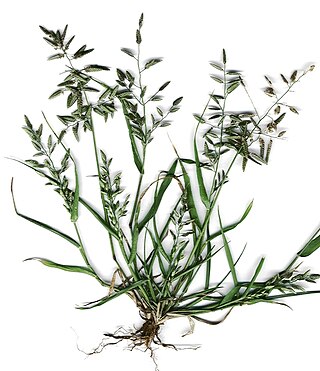
Eragrostis is a large and widespread genus of plants in the grass family, found in many countries on all inhabited continents and many islands.
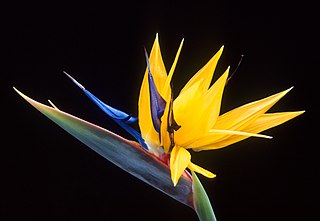
Strelitzia is a genus of five species of perennial plants, native to South Africa. It belongs to the plant family Strelitziaceae. A common name of the genus is bird of paradise flower/plant, because of a resemblance of its flowers to birds-of-paradise. In South Africa, it is commonly known as a crane flower.

Othonna is a genus of approximately 90 species of succulent or subsucculent perennial herbs or shrubs, with its center of diversity in the Greater Cape Floristic Region (GCFR) of South Africa but some species' ranges include southern Namibia, Angola, and Zimbabwe. The genus was established by Linnaeus in 1753 containing 14 species, however, of those original species, only four are still retained in Othonna, while the others have been transferred to different genera including Cineraria, Euryops, Hertia, Ligularia, Senecio, and Tephroseris. The genus Othonnna is known to be monophyletic. In 2012, a new genus Crassothonna B. Nord. was erected with 13 species transferred from Othonna. A complete modern taxonomic treatment of the genus is being undertaken by the Compton Herbarium and the South African National Biodiversity Institute. The first part, a revision of the Othonnna bulbosa group, was published in 2019.
Lophacme is a genus of African plants in the grass family.

Kumara is a genus of two species of flowering plants in the subfamily Asphodeloideae, native to the Western Cape Province of South Africa.
Terence Macleane Salter was a British/South African plant collector and botanist. Among the plant taxa named in his honor are the genus Saltera (Penaeaceae) and the orchid Disa salteri.
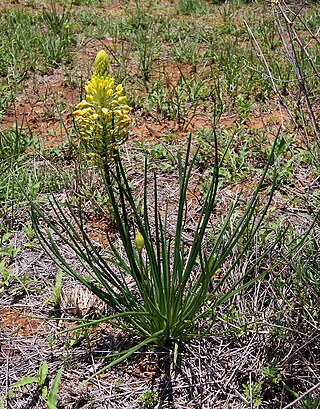
Bulbine abyssinica is a species of plant in the genus Bulbine, from eastern and southern Africa.

Lobostemon is a genus of flowering plants belonging to the family Boraginaceae. It is endemic to the Cape Provinces of South Africa. The majority of species are limited to the winter rainfall area of the country, from Springbok to Mossel Bay. In Afrikaans these species are known as agtdaegeneesbos, or loosely translated, bush that will heal in eight days. As this name suggests, many species have medicinal properties. This is best known from Lobostemon fruticosus, which is used for treating wounds, blood poisoning, ringworm, skin diseases and syphilis.
Mossia is a monotypic genus of flowering plants belonging to the family Aizoaceae. It only contains one known species, Mossia intervallaris.
Stayneria is a genus of flowering plants belonging to the family Aizoaceae. It contains a single species, Stayneria neilii. It is in the subfamily Ruschioideae and the tribe Ruschieae.

Dais is a genus of flowering plants in the family Thymelaeaceae. It is also part of the Gnidia subfamily, along with Gnidia, Drapetes, Kelleria, Pimelea, Struthiola, Lachnaea and Passerina, other genera of species). It is distributed between Tanzania to S. Africa, Madagascar. It is native to the countries of Eswatini, Lesotho, Madagascar, Malawi, Tanzania, Zimbabwe and it is also found within several Provinces of South Africa, such as Cape Provinces, Free State, KwaZulu-Natal and Northern Provinces.
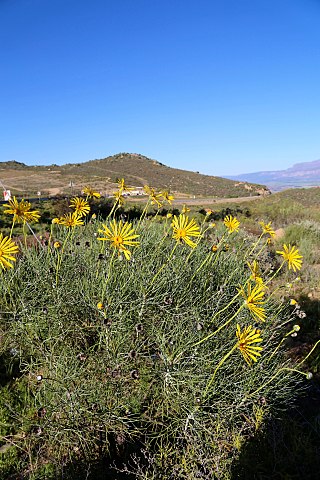
Euryops speciosissimus is a species of flowering shrub in the genus Euryops. It is endemic to the fynbos region of South Africa. It is also known as the Clanwilliam daisy and giant resinbush; in Afrikaans it is called harpuisbos, meaning resin bush.

Ixia scillaris is a perennial cormous flowering plant in the genus Ixia. It is endemic to a small portion of the Fynbos in the Western Cape.

Stachys rugosa is a species of perennial herb in the genus Stachys.

Lebeckia plukenetiana is a species of flowering plant in the genus Lebeckia. It is endemic to the Western Cape of South Africa.
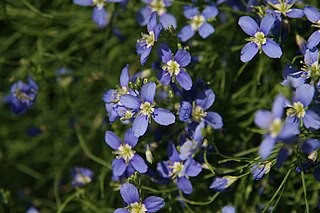
Heliophila coronopifolia is a species of flowering plant in the genus Heliophila. It is native to the Northern Cape and Western Cape provinces of South Africa.
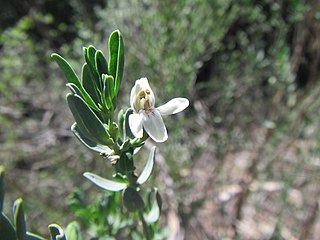
Justicia cuneata is a species of subshrub in the genus Justicia. It is native to Namibia and the Cape Provinces of South Africa.

Roepera morgsana is a succulent plant species in the genus Roepera. It is endemic to Namibia and the Cape Provinces of South Africa.

Limeum africanum is a species of flowering plant in the genus Limeum. It is endemic to Southern Africa. It is also known by the names common lizardfoot and koggelmandervoet; Afrikaans for the foot of a lizard from the genus Agama.

Lapeirousia pyramidalis is a species of geophyte in the genus Lapeirousia. It is endemic to the Cape Provinces of South Africa. It is also known as the pyramid kabong.

















